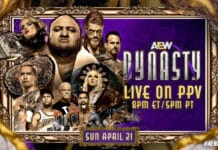I penned an article earlier this week about the lack of “must see” television within the WWE product, mostly because Drew McIntyre’s run as WWE champion was interrupted for a three-week stint by Randy Orton that was essentially meaningless within the grand scheme of things. Orton is already established and over as much as he’s going to be in his career. Instead of Drew potentially set up for an angle that leads to a big match down the road where he has a year long title reign at stake, that scenario was sacrificed for a three-week title reign that made no progress for storylines. As mentioned, if a viewer skipped a month of Raw, what did they really miss? Drew is the champion and still involved in a feud with Orton. During the previous article, I explained that too often, WWE uses wrestlers and storylines like interchangeable parts and thus often times the results of specific matches don’t have any impact on the overall direction of the brands. The 50/50 booking aspect, something that the Drew/Orton exchange is a prime example of, created a level of mediocrity around the product. With the exception of very few on the roster, individual performers aren’t put in a position where they could potentially affect the numbers since most wrestlers are kept at relatively the same level. Instead of making legitimate money-drawing stars, the WWE brand is promoted as the selling point, but there’s a ceiling for that because there’s not a direct connection between the wrestlers on screen and the audience, which is why WWE business plateaued at various points in the past few years.
It’s very disappointing because as a fan of professional wrestling, you want to hope for the best product possible. There are so many thrilling moments and truly good things that can come from the spectacle of sports entertainment, but why have things become such a paint-by-numbers product?
I attempted to figure this out, and thought back to a grainy promo I found on Youtube over a decade ago where the late great, “Rowdy” Roddy Piper had the mic to hype an upcoming tag team title cage match with his tag partner Rick Martel against The Sheepherders, the wild pair of New Zealand grapplers years before they worked a comedy gimmick in the WWF. As Piper ranted, he smashed a legitimate beer bottle over his head and with blood streaming down his face proclaimed, “getting this title in the cage is going to make $45,000 difference in my annual earnings, brother!”
Bingo! That’s the point, Roddy gave the fans the reason they had to be at the arena to see this cage match and he emphasized its importance. He claimed there was an extra $45,000 on the line for him if he could wrestle as one of the tag team champions, and something as simple as financial security is something the audience can identify with for the narrative of a storyline. Plus, if “Rowdy” Roddy was willing to smash a bottle of his head and bleed just to prove a point, what was he going to do when he had the villains in the cage with the World Tag Team titles on the line?
Granted, it’s a different time, but the point is, when Drew can win the belt back within three weeks, should the fans really be concerned if he loses it again? Furthermore, should they be emotionally invested the next time the title is on the line? If he can win it back in three weeks, what’s the point of the audience trying to rally around him for victory? More specifically, where’s the heat for the heel that beats him? It’s basically, “don’t worry about it, Drew will win it back”
As I’ve written many times before, the emotional investment from the audience, even today, is still the key to drawing money. The problem of today is that WWE brass uses the emotional investment associated more with the nostalgia from the stars of the past than to present storylines that can allow the current roster to connect with the fans. Perhaps, some of the key mistakes made at critical times of the past decade have come back to bite the company in some form or fashion. CM Punk wasn’t the next Stone Cold, but he made pro wrestling a part of the main stream discussion for the first time in years and within a month or two, he was pinned by Triple H to squash the momentum. Despite the injuries, Daniel Bryan should’ve been given the chance be the top guy in the company way before the audience taking over shows forced the writing team to take the product in that direction. Maybe if a few key guys got the chance to truly run with the spot as the top star, the ratings wouldn’t have steadily declined the past few years.
Again, I ask myself, why isn’t more invested into individual stars to allow for a broader draw to the general audience? For example, not everyone that started to watch pro wrestling in 1998 was a diehard wrestling fan, but they certainly became fans of certain stars. A lot of Stone Cold Steve Austin fans simply quit watching when he didn’t wrestle on Monday nights.
As I said, the WWE brand is promoted as the draw, not specific stars. There are pros and cons to that, if a wrestler gets hurt, the writing team can plug someone else into that spot rather seamlessly and the shows continue without much inconvenience. Also, it gives the company more power because there’s usually not one competitor with enough star to really shift the dynamic of the company. If there’s a contract dispute and someone would leave the company, it doesn’t have as much of a dent in the overall production. The flip side is the plateaued level discussed prior to this since there’s only a specific group of people that will follow the WWE brand regardless of the wrestlers pushed on TV.
I searched my mind for an answer about why are things so bland. There was a title change on Raw, a very rare occasion, but the circumstances around it with the three-week reign take a lot of the sizzle away from it. There’s a generic formula with the 50/50 booking element so there just isn’t much at stake with the vast majority of WWE storylines. As complex as the subject might be with the numerous parts that fuel the WWE machine and the multiple points the company has to cover within the context of its product, the answer is rather simple.
The global publicly-traded company serves its stockholders ahead of its fans. From purely a business prospective, that’s a very wise decision, at least for the moment. Keep in mind, the WWE landed its mega TV deals with USA and Fox that ensured them record-setting profits for the next five years because of the dynamics within the TV business, not necessarily because of a demand for more pro wrestling content. In order to satisfy those hefty contracts and to continue to tout the major profits they bring, the WWE machine continues to churn out countless hours of content. It’s quite literally the quantity, not that quality that has allowed WWE brass to discuss the profit of the $2.4 billion TV contracts during conference calls. The easiest example is that Raw became a three-hour show because USA was willing to pay for a third hour, but the effect was a noticeable dip in quality because it’s much more difficult to produce an extra hour of solid content that will retain the audience. WWE management continues it’s usual approach because it’s a steady path that keeps them on track to make the major TV money. The flip side is, while this cookie-cutter approach to the product maintains status quo for now in terms of profitability, it’s also eroding the core audience. Does anyone really think the company will get another billion dollar contract for Raw when the current USA contract expires in a few years? All of this is done to keep the stockholders there, but is that really the same demographic that follows the product? The bottom line is, how many wrestling fans are corporate investors?
At some point, the WWE’s corporate approach of the same play book is going to come back to bite them. They don’t take any truly new chances with the direction of the promotion because they don’t want to rock the boat or sour potential shareholders. It’s much more typical sports entertainment to present Roman Reigns as the top star than CM Punk or Daniel Bryan. The fact that Reigns had to turn heel should be proof that the generic “WWE wrestler” hype that might draw the shareholders because of the numbers associated with Wrestlemania doesn’t connect with the actual WWE audience. Don’t get me wrong, the WWE is very successful from a business perspective, but it’s very possible that the decisions to maximize the profit from the stock price now will be the reason the audience declines in the future.
What do you think? Comment below with your thoughts, opinions, feedback and anything else that was raised.
Until next week
-Jim LaMotta
E mail [email protected] | You can follow me on Twitter @jimlamotta







